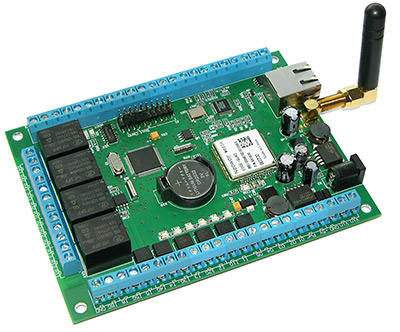
Appearance of the Laurent 5G module from KernelChip The
new product from KernelChip ( www.kernelchip.ru ) is made on a printed circuit board with dimensions of 101 X 135 mm. The quality of the board and the installation of components are at a high level, no traces of soldering and flux. The manufacturer declared guaranteed operation of the board in the temperature range of -30 +70 degrees Celsius.
The module has a very decent set of hardware resources: 4 controlled relays 220V / 7A, 6 input, galvanically isolated dry contact lines, 5 output power lines 0.5A capable of switching voltage up to 50V, 8 general-purpose GPIO lines, 4 PWM channels, connected to the first four output lines, 5 ADC channels on a highly stable reference, RS-232 port, 14 pulse counters, 2 1-Wire channels, non-volatile real time clock (RTC), built-in 2G modem.
The module can be controlled via the RJ45 port with a nice and convenient WEB interface. Moreover, two WEB-interfaces are supported: hardware-wired and alternative, custom, loaded into non-volatile memory. It also supports direct URL command management and through an open API with feedback. The module has the ability to configure a TCP client on a separate port to connect, for example, several Laurent modules to a centralized management server, without interfering with the operation of the TCP server of each module. Direct M2M communication can be configured between KernelChip modules.
The module has a software, constantly expandable by the manufacturer, an event scheduler that allows you to organize scenarios between certain conditions and module reactions. Among the latest innovations in the CAT scheduler is support for dynamic variables that reflect the state of individual hardware resources of the module and sensors, as well as custom variables that can be used to introduce additional conditions for reactions to events.
The module's GSM-modem allows receiving arbitrary messages and sending messages from the module to specified numbers (so far only in English) up to 70 characters long. Thanks to the flexible integration with the CAT scheduler, you can specify any "names" for executing user commands via the CMC, rather than using hard-coded commands, as in most similar products from other manufacturers. The modem also allows organizing event management on the module via DTFM commands from the phone and immediately upon a call. It is possible to customize "white" numbers (up to 30).
Laurent-5G supports work with many new types of sensors: DS18B20 digital temperature sensor (up to 20 sensors), DHT11 digital humidity and temperature sensor, 220 V presence sensors, current sensors, reed switches for door open / close, water leakage, excess noise level, shock / vibration, glass breakage, illumination, movement. Data processing from RFID (Wiegand-26/42) and iButton (Touch Memory DS1990) are also supported. Probably the set of sensors will be expanded, but what is available is more than enough.
Like all KernelChip products, the Laurent 5G module is certified and manufactured in Russia.
So, unlike its predecessor Laurent-2G, the new Laurent-5G has many useful innovations and improvements: built-in real time clock, which was clearly lacking in its predecessor, support for many new types of sensors, more ADC channels, a modified WEB interface with an improved scheduler system CAT events.
Unfortunately, the current latest firmware of the module dated November 02, 2020 does not yet support the mail client, which does not allow sending e-mail messages. DHCP client is also not supported (only static IP address is configured). It also does not support receiving time via NTP, internal event logging is not supported, and there is no support for Syslog and SNMP, which any admin would like to have. The firmware update is carried out by a special proprietary utility, although it is preferable that it be possible to update the firmware also through the WEB interface.
There are minor remarks and shortcomings in the CAT-events system editor, but no errors were noted in its work.
The device is traditionally sold in the form of a printed circuit board, not a finished device, which makes it incorrect to compare it with complete domestic devices for monitoring sensors and power management, such as, for example, Netping 4 SMS (Alentis Electronics LLC, www.netping.ru ) or SNR-ERD-4s-GSM (LLC "NAG", https://nag.ru ), which also differ in an affordable price compared to foreign counterparts. However, there is every reason to hope that with a clearly richer hardware base, tireless constant and operational work of the development team on module improvements, Laurent-5G, as part of a complete monitoring and control device, will soon take its rightful place among these devices and can clearly make them competition.
The manufacturer wins over its competitors by not hiding the module board from the user's wide view, providing full detailed descriptions and an open SDK for creating its own WEB interface. The ability to support the user WEB-interface is also an advantage of this module, allowing you to support both functionally alternative firmware, and, for example, support in the WEB of two languages, English and an arbitrary national.
Sold as a stand-alone board, the Laurent-5G can be integrated into any professional monitoring and control system. For a complete separate device, the module lacks a good stylish case with indication and connectors for connecting power and peripherals. In the case version, I would also like to see a built-in uninterruptible power supply unit with a capacious lithium battery, the charging and state of which would be controlled by the module itself.
In anticipation of the finished box device, I decided to install the Laurent 5G board myself in a good aluminum case, additionally providing buttons and a remote control, but more about that in my next article.
In the meantime, all that remains is to thank the development team for a good product and wish further success in the early development of Laurent-5G and the creation of new modules.